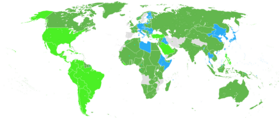Allies of World War II
| Allies of World War II | ||||||||||||
| United Nations | ||||||||||||
| Military alliance | ||||||||||||
|
||||||||||||
Combatant States:
|
||||||||||||
| Capital | Not specified | |||||||||||
| Political structure | Military alliance | |||||||||||
| Historical era | World War II | |||||||||||
| • | Established | 1939 | ||||||||||
| • | Disestablished | 1945 | ||||||||||
|
||||||||||||
The Allies of World War II, called the United Nations from the 1 January 1942 declaration, were the countries that together opposed the Axis powers during the Second World War (1939–1945). The Allies promoted the alliance as seeking to stop German, Japanese and Italian aggression.
At the start of the war on 1 September 1939, the Allies consisted of France, Poland and the United Kingdom, and dependent states, such as the British India. Within days they were joined by the independent Dominions of the British Commonwealth: Australia, Canada, New Zealand and South Africa. Poland was a minor factor after its defeat in 1939; France was a minor factor after its defeat in 1940. From the German invasion of North Europe to the Balkan Campaign, Netherlands, Belgium, Greece and Yugoslavia joined the Allies. After first having cooperated with Germany in invading Poland whilst remaining neutral in the Allied-Axis conflict, the Soviet Union perforce joined the Allies in June 1941 after being invaded by Germany.The United States provided war materiel and money all along, and officially joined in December 1941 after the Japanese attack on Pearl Harbor. China had already been into a prolonged war with Japan since the Marco Polo Bridge Incident of 1937, but officially joined the Allies in 1941.
...
Wikipedia

